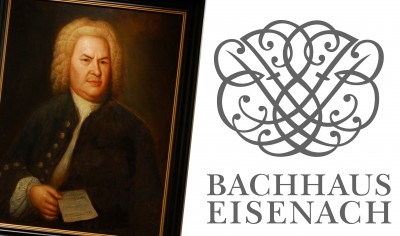Original choir parts of Mendelssohn’s 1829 performance of Bach’s St Matthew Passion, to go on display in Jerusalem. Photo: Bach House, Eisenach.
04.03.2016
Brought Back by a Jewish Boy:
Bach’s St Matthew Passion
Original material from Felix Mendelssohn Bartholdy’s legendary performance of Bach’s long-forgotten St Matthew Passion in Berlin in 1829 goes on display in Jerusalem from 17 to 21 March 2016. The exhibition by the Bach House, Eisenach, Germany, accompanies the first Jerusalem Bach Festival during which the work will be performed twice under conductor Joshua Rifkin.
When on 11 March 1829 Bach’s St Matthew Passion was performed again for the first time after Bach’s death by the just 20-years-old Felix Mendelssohn Bartholdy in Berlin, it was a spectacular success. The hall of the Berlin Sing-Academy was sold out, more than 1000 Berliners had to be sent away, and the concert had to be repeated two times. The newspapers were full of praise, calling it “the greatest musical work of all times” and the “holiest work of art created by the Germans”. Mendelssohn’s legendary performance became the starting point of the “Bach renaissance”, the world-wide enthusiasm for Bach’s music that still continues today.
The spectacular success of staging Bach’s long forgotten music caught even Mendelssohn by surprise. “What a miraculous coincidence”, he said to his co-organizer of the event, the actor and comedian Eduard Devrient, “that it required a comedian and a Jewish boy to bring the greatest Christian music back to the people!” Mendelssohn had been given a copy of the score of the St Matthew Passion in 1823 by his grandmother Bella Salomon. Bella had grown up in a household dominated by the music of the Bach family and like the philosopher Moses Mendelssohn, the father of her son-in-law and grandfather of Felix, she had received music lessons from Bach’s own pupil Philipp Kirnberger. When got to know the Bach collector Georg Poelchau in 1799, who owned Bach’s handwritten score of the St Matthew Passion, the proud Jewess was one of the first to recognise the significance of the work. She asked Poelchau for a copy which she then passed to Mendelssohn when he was fourteen, one year before her death in 1824. Mendelssohn studied the music and started rehearsing it with his co-students at the Sing-Academy – much to the chagrin of his teacher Carl Friedrich Zelter who thought the work “too bristly” for contemporary ears and just lukewarmly supported the project. It is from Bella’s score that Mendelssohn and his friends copied the music for their ground-breaking performance in 1829.
A set of eight original choir parts from Mendelssohn’s 1829 performance will be on display in the Jerusalem Theatre (Center for the Performing Art), from 17 to 21 March. Since the original material was scattered after it had been re-used in 1854 for the first performance of the St Matthew Passion in England by the London Bach Society, and only in 2013 a large part of it could be acquired from a private collector by the Bach House in Eisenach, Germany, the museum at the birth-place of the composer, it will be the first time that some of the material is on display in Israel. The exhibit focusses on the history of the St Matthew Passion and its rediscovery in the early 19th century. Two films in the rooms explain the significance of the work and also address the question whether Bach’s Passion music is in any way “anti-Jewish”. “The question has been asked since Nazi musicologist Karl Hasse first stipulated an Anti-Judaism of Bach in 1941”, says Joerg Hansen, the museum’s director and curator of the exhibit. “But there is no evidence for this.”
The exhibition was invited by the organizers of the Jerusalem Bach Festival, the Jerusalem Baroque Orchestra. It is funded by the Free State of Thuringia, Germany, and supported by the New Bach Society (Neue Bachgesellschaft, Leipzig, Germany), the society that owns the museum since 1907 and also first initiated the tradition of Bach Festivals that are held world-wide since 1901.
Place: Jerusalem Theatre (Center of the Performing Arts), Lobby of Henry Crown.
Opening and gallery talk: Thursday 17 March, 15:30. With Dr. Jörg Hansen, curator of the Exhibit and director of the Bach House, Eisenach, Germany.
Exhibition times: 17–21 March, opening hours: Thursday 15:30 – 21:30, Friday 12:00 – 15:00, Saturday 19:00 – 21:30, Sunday, Monday 16:30 – 21:30.
Website Jerusalem Bach Festival: http://www.jbo.co.il/
Downloads:
Photos, free for media reporting. Please left-click to start download of a high resolution version.
| Choir parts from Mendelssohn’s 1829 performance, on display in Jerusalem 17-21 March 2016. Photo: Bach House, Eisenach. |
| Building of the Sing-Academy in Berlin where Mendelssohn performed the St Matthew Passion on 11 March 1829. Photo: Bach House, Eisenach. |
|
Bella Salomon née Itzig (1749–1824). Tempera on ivory, ca. 1800. Photo: Mendelssohn-Remise, Berlin / Manfred Claudi. |
|
Felix Mendelssohn Bartholdy (1809–1847) at age 12. Engraving after a painting by Carl Joseph Begas, 1821. Photo: Bach House, Eisenach. |
